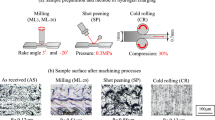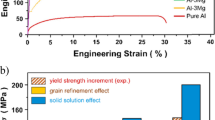Abstract
In this study, the effects of deep cryogenic treatment (93 K) on the surface and sub-surface wear development of H13A cobalt-bonded tungsten carbide cutting inserts during the wet machining of AISI 1045 steel were investigated. Cutting inserts were subjected to short periods (171–553 s) of turning at cutting speeds of 50–140 m/min, during which time mass measurements were taken and the worn edges were imaged and scanned, by optical microscopy and light interferometry, at regular intervals. Sections were taken following machining so that sub-surface features could be observed by scanning electron microscopy. It was determined that cryogenic treatment resulted in a 9.2 % increase in hardness and an increase in abrasive wear resistance, although microstructural changes and sub-surface behaviours suggested a corresponding decrease in toughness may have occurred.









Similar content being viewed by others
References
Das D, Ray KK, Dutta AK (2009) Influence of temperature of sub-zero treatments on the wear behaviour of die steel. Wear 267(9–10):1361–1370
Preciado M, Bravo PM, Alegre JM (2006) Effect of low temperature tempering prior cryogenic treatment on carburized steels. J Mater Process Technol 176(1–3):41–44
Stratton PF (2007) Optimising nano-carbide precipitation in tool steels. Mater Sci Eng Struct Mater Prop Microstruct Process 449:809–812
Lal DM, Renganarayanan S, Kalanidhi A (2001) Cryogenic treatment to augment wear resistance of tool and die steels. Cryogenics 41(3):149–155
Molinari A et al (2001) Effect of deep cryogenic treatment on the mechanical properties of tool steels. J Mater Process Technol 118(1–3):350–355
Huang JY et al (2003) Microstructure of cryogenic treated M2 tool steel. Mater Sci Eng Struct Mater Prop Microstruct Process 339(1–2):241–244
da Silva FJ et al (2006) Performance of cryogenically treated HSS tools. Wear 261(5–6):674–685
Cajner F et al (2009) Effect of deep-cryogenic treatment on high speed steel properties. Mater Manuf Process 24(7–8):743–746
Das D, Dutta AK, Ray KK (2010) Sub-zero treatments of AISI D2 steel: part I. Microstructure and hardness. Mater Sci Eng Struct Mater Prop Microstruct Process 527(9):2182–2193
Das D, Dutta AK, Ray KK (2010) Sub-zero treatments of AISI D2 steel: part II. Wear behavior. Mater Sci Eng Struct Mater Prop Microstruct Process 527(9):2194–2206
Amini K et al (2012) Effect of deep cryogenic treatment on the properties of 80CrMo12 5 tool steel. Int J Miner Metall Mater 19(1):30–37
Podgornik B et al (2012) Improving tribological properties of tool steels through combination of deep-cryogenic treatment and plasma nitriding. Wear 288:88–93
Bensely A et al (2005) Enhancing the wear resistance of case carburized steel (En 353) by cryogenic treatment. Cryogenics 45(12):747–754
Liu HH et al (2006) Effect of cryogenic treatment on property of 14Cr2Mn2V high chromium cast iron subjected to subcritical treatment. J Iron Steel Res Int 13(6):43–48
Yang HS et al (2006) Effect of cryogenic treatment on the matrix structure and abrasion resistance of white cast iron subjected to destabilization treatment. Wear 261(10):1150–1154
Zhirafar S, Rezaeian A, Pugh M (2007) Effect of cryogenic treatment on the mechanical properties of 4340 steel. J Mater Process Technol 186(1–3):298–303
Zhu YZ et al (2008) Effects of cryogenic treatment on mechanical properties and microstructure of Fe-Cr-Mo-Ni-C-Co alloy. J Cent South Univ Technol 15(4):454–458
Baldissera P (2010) Deep cryogenic treatment of AISI 302 stainless steel: part I—hardness and tensile properties. Mater Des 31(10):4725–4730
Baldissera P, Delprete C (2010) Deep cryogenic treatment of AISI 302 stainless steel: part II—fatigue and corrosion. Mater Des 31(10):4731–4737
Jaswin MA, Lal DM, Rajadurai A (2011) Effect of cryogenic treatment on the microstructure and wear resistance of X45Cr9Si3 and X53Cr22Mn9Ni4N valve steels. Tribol Trans 54(3):341–350
Slatter T, Lewis R, Jones AH (2011) The influence of cryogenic processing on wear on the impact wear resistance of low carbon steel and lamellar graphite cast iron. Wear 271(9–10):1481–1489
Thornton R et al (2011) The effects of cryogenic processing on the wear resistance of grey cast iron brake discs. Wear 271(9–10):2386–2395
Thornton R, Slatter T, Ghadbeigi H (2013) Effects of deep cryogenic treatment on the dry sliding wear performance of ferrous alloys. Wear 305(1–2):177–191
Lulay KE, Khan K, Chaaya D (2002) The effect of cryogenic treatments on 7075 aluminum alloy. J Mater Eng Perform 11(5):479–480
Sun QY et al (2004) Mechanical behavior and deformation mechanisms of Ti-2.5Cu alloy reinforced by nano-scale precipitates at 293 and 77 K. Mater Sci Eng Struct Mater Prop Microstruct Process 364(1-2):159–165
Xiong CX et al (2007) Effects of cryogenic treatment on mechanical properties of extruded Mg-Gd-Y-Zr(Mn) alloys. J Cent South Univ Technol 14(3):305–309
Yong J, Ding C, Qiong J (2012) Effect of cryogenic thermocycling treatment on the structure and properties of magnesium alloy AZ91. Met Sci Heat Treat 53(11–12):589–591
Zhang ZZ et al (2009) Enhanced wear resistance of hybrid PTFE/Kevlar fabric/phenolic composite by cryogenic treatment. J Mater Sci 44(22):6199–6205
Zemzemi F et al (2008) New tribometer designed for the characterisation of the friction properties at the tool/chip/workpiece interfaces in machining. Tribotest 14:11–25
Astakhov VP (2004) The assessment of cutting tool wear. Int J Mach Tools Manuf 44:11
Robinson GM, Jackson MJ, Whitfield MD (2007) A review of machining theory and tool wear with a view to developing micro and nano machining processes. J Mater Sci 42(6):2002–2015
Subramanian SV, Ingle SS, Kay DAR (1993) Design of coatings to minimize tool crater wear. Surf Coat Technol 61:7
Seah KHW, Rahman M, Yong KH (2003) Performance evaluation of cryogenically treated tungsten carbide cutting tool inserts. Proc Inst Mech Eng Part B J Eng Manuf 217(1):29–43
Thakur D, Ramamoorthy B, Vijayaraghavan L (2008) Influence of different post treatments on tungsten carbide-cobalt inserts. Mater Lett 62(28):4403–4406
SreeramaReddy TV et al (2009) Machinability of C45 steel with deep cryogenic treated tungsten carbide cutting tool inserts. Int J Refract Metal Hard Mater 27(1):181–185
Gill SS et al (2012) Metallurgical and mechanical characteristics of cryogenically treated tungsten carbide (WC-Co). Int J Adv Manuf Technol 58(1–4):119–131
ISO (1993) Tool-life testing with single-point turning tools. International Organization for Standardization, Geneva, Switzerland, p 56
Gill SS et al (2011) Flank wear and machining performance of cryogenically treated tungsten carbide inserts. Mater Manuf Process 26(11):1430–1441
Gill SS et al (2011) Investigation on wear behaviour of cryogenically treated TiAlN coated tungsten carbide inserts in turning. Int J Mach Tools Manuf 51(1):25–33
Vadivel K, Rudramoorthy R (2009) Performance analysis of cryogenically treated coated carbide inserts. Int J Adv Manuf Technol 42(3–4):222–232
Acknowledgments
The authors wish to acknowledge the support of Sandvik Coromant UK (http://www.sandvik.coromant.com/en-gb/) for providing the tungsten carbide tool inserts used in this study, and Cryogenic Treatment Services Ltd. (http://www.195below.co.uk/) for the provision of the deep cryogenic treatment provided.
Author information
Authors and Affiliations
Corresponding author
Rights and permissions
About this article
Cite this article
Thornton, R., Slatter, T. & Lewis, R. Effects of deep cryogenic treatment on the wear development of H13A tungsten carbide inserts when machining AISI 1045 steel. Prod. Eng. Res. Devel. 8, 355–364 (2014). https://doi.org/10.1007/s11740-013-0518-7
Received:
Accepted:
Published:
Issue Date:
DOI: https://doi.org/10.1007/s11740-013-0518-7




